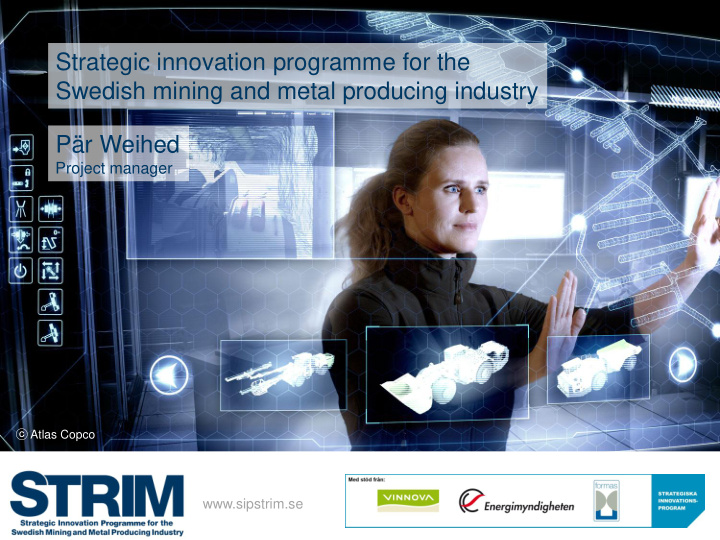



Strategic innovation programme for the Swedish mining and metal producing industry Pär Weihed Project manager ⓒ Atlas Copco www.sipstrim.se
Strategic innovation programme Strategic innovation agenda (SIP)
Key Performance Indicators
New approaches: • Mining towards continuous processes • Better methods to characterize the host rock and the ore to maximize the inherent values as well as to minimize non- marketable residues • Better command of “ soft factors ” , stimulate improved safety culture and change image of the sector • Nurture a cross-sectorial transfer of knowledge and experience to master the challenges ahead
Anticipated effects 2013 – 2016: • Sweden has become a well-known and appreciated EU research and innovation partner • The Swedish mining cluster has been strengthened and the technology providers offer new or improved products and services • The environmental footprint has been reduced by lower emissions and improved resource and energy efficiency • The mining and metal producing sector has become more attractive for young talented men and women • The global competitiveness and sustainability has been further strengthened
Research and Innovation projects, activities , c. 200 MSEK 2013 – 2016 TRL-level 4-7
Organisations supporting the SIP STRIM (signed LoI) Industry Academia ABB Luleå University of Technology Atlas Copco Umeå University Boliden Uppsala University LKAB Public organisations Lunding Mining (Zinkgruvan AB) Geological Survey of Sweden Raw Materials Group Research institutes Sandvik Swerea MEFOS SKB SP Stena Recycling NGOs Bergkraft Georange Financial “ committment ” approx. 100 MSEK 2014 – 2016
Innovative Deep Exploration INDEX Klas Hjort Uppsala University www.gruvochmetallutvinning.se www.siostrim.se
Partners • Uppsala University: geophysics, geochemistry, microsystems technology • Atlas Copco: gatekeeping, drilling technology implications • Boliden: end user, field tests geophysics borehole probes/shuttles and Orexplore’s geochemical system • LKAB: end user, field tests geophysics borehole probes/shuttles • Orexplore: technology developer X-ray geochemical system: deep XRF and tomography
Objectives and goal • Deep exploration beyond one kilometre can benefit greatly by getting faster feedback on the physical and chemical state of the rock. • The goal is to improve the work flow and creativity for geologists by new technology for geophysical sensors and geochemical analyses at the bore hole. • New miniaturized technology for sensors and chemical analysis will be developed and tested in the field. The study will have a particular focus on the problems and needs arising from the exploration at depths greater than one kilometer. • This project is the first phase of three, which shall help distinguish Swedish industry from existing research and development in the world.
Pre-study inspired by DET-CRC • Uppsala University • Drilling technology • Luleå Technical University • Geology • Acreo • Geo physics • KIMAB • Geo chemistry • LKAB • Sensor • Boliden • Materials science • Atlas Copco • Miniaturized systems • Wassara • Orexplore • (SGU)
Inspiration from DET CRC • Three focus areas • Drilling • Logging • Chemistry
Lab-at-Rig of REFLEX
Hyperspectral core logging • SEG 2015: High-Resolution VNIR-SWIR Core Logging: A Revolutionary New Tool for Exploration, Mining, and Research – Newcrest Mining Limited, Melbourne 3004, Australia – Corescan Pty Ltd, Belmont 6104, Australia • A new multisensor automated high-speed hyperspectral core logging platform provides a step change in characterization of ore systems. • With a spatial resolution down to 0.5 mm, complete drill core-based , deposit-scale petrographic studies of relevance to exploration , mining, and research. • Needs huge data handling and spectral classification and mineral identification algorithms process each spectral pixel and compare the response to an established mineral library: on-site handling!
LKAB and Boliden want collaboration between Atlas Copco and Wassara • Fast hammer until we reach interesting depths and from there diamond core drilling • Support for drilling: digitalized rigg; sensors and chemical analyses at the drilling rigg; direct visualization • Analyse of drill mud (cf. DET CRC) and core for support
Mini-sub • From studies of sub-glacial lakes • Large like two cans in row • Specially developed miniaturized instruments: microsonar, diffractive laser optics for 3D camera, salinity sensor, flow sensor, particle collector • Fibre optics for data and energy transfer
World class miniaturization
Down hole magnetometers Frequency range for AMT and CSAMT: 1 Hz -10 kHz Define requirements from surface sensors Wants 3D-SQUID
Seismic measurements at drilling
Data handling and modeling
Orexplore • Orexplore is developing an X-ray instrument that can be used at the drilling site (600 kg cabinet transported in small container). • This AXM instrument (Attenuation and XRF combined Measurement) do deep XRF and heavy element X-ray absorption tomography with dual heads. One meter lengths of core will take less than 20 min. • In normal procedure, this is a push-and-play instrument. Today for elements between atom number 25 and 82 (Mn Pb) • • The aim is to reach down to atom number 13 (Al) Mikael Bergqvist Ph.D. R&D Manager, Orexplore AB mikael.bergqvist@orexplore.com +46701731770 www.orexplore.com
To bring with you • There are much more ore in the depth • We need to reduce exploration costs • Innovative deep exploration may improve creativity • New miniaturized sensors in the bore hole and chemical analyses at its side • Want to increase international collaboration
Recommend
More recommend